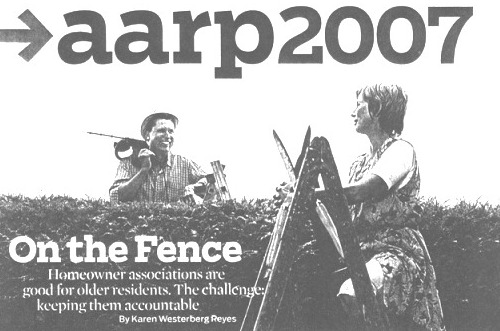
|

|
and lines of demarcation. One could argue that homeowners' associations (HOAs), technically defined as organizations created to manage the affairs of common-interest communities, are a kind of legal fence, a way to comfortably divide what belongs to whom so all parties are protected -- and managed. In short, to ensure the common good.
Oh, if it were only that easy! Sure, there are many good homeowner (also called property-owner or community) associations. Unfortunately, according to an AARP Public Policy Institute report written by attorney David A. Kahne, there are some that aren't so good. "Most residents are fine with their HOAs until a dispute arises, says Andy Kochera, AARP senior policy adviser. "Then they find out just how powerful they really are." But to be fair, adds Kochera, even the most honest HOA can come off as the bad guy, because in most disputes they have to act as judge, jury -- and enforcer.
When you consider that 6,5 million 50-plus households resided within an HOA environment in 2005 (almost double that of the 3,7 million in 1995), you get an idea of the potential for problems. Take the case of the 82-year-old Texas widow who owed $814.50 in back dues and lost her $150,000 property to foreclosure. Or the Arizona couple who had a %66 association debt and ended up paying more than $7,000 in lawyer's fees to save their home.
After studying some of the most common HOA problems-- which include inadequate state regulation, few options for resolving resident conflicts, and the too-quick use of foreclosure--AARP published a sample model statute that contains key protections for all HOA-governed homeowners. It provides guidance to state lawmakers, association board members--and residents.
In addition, AARP condensed the basic principles of the statute down to
a bill of Rights for Homeowners. We know HOA-governed communities are good for older people," says Kochera. They offer community, a
neighborhood infrastructure, and social opportunities. All important aspects for helping people stay in their
homes well into old age." http://assets.aarp.org/rgcenter/consume/2006_15_homeowner.pdf |